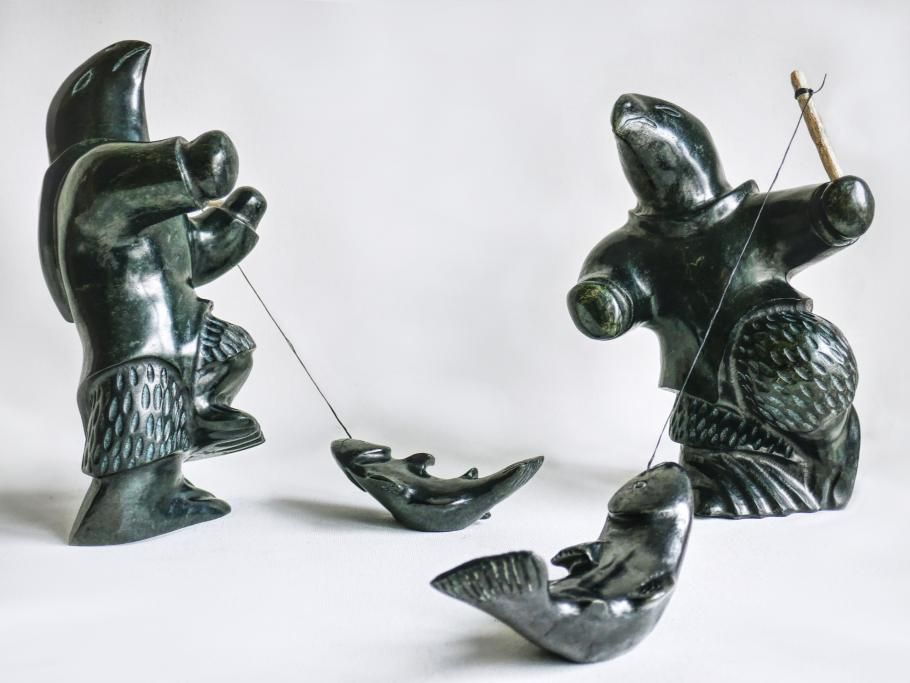
Shopping the Old Way", a soapstone carving by Malaya Pitsiulak from Pangnirtung, Nunavut, made in 2022.
Art exhibition tells a story
For more than a decade, Myra Hird (School of Environmental Studies) has been working with the Inuit community of Panniqtuuq (Pangnirtung), Nunavut on waste issues. One of her PhD students, Micky Renders, has been working for the past four years with several Inuit artists to create art that engages with waste issues from a Truth and Reconciliation perspective.
One outcome of this relationship-building, collaboration and research is the Art and Wastes in Panniqtuuq, Nunavut exhibition. The Exhibition’s contributors – including Inuit Elders, artists, and youth – have taken a broad-ranging conceptual approach to animating their lived experiences, and the sculptures, photographs, tapestry and other art works provide profound insights into the contemporary history of Canada, waste issues, and Truth and Reconciliation.
The public is invited to the Welcoming Celebration on Tuesday, October 24 at the Isabel Centre for the Performing Arts starting at 6:30 pm. Special guests at the event include Provost and VP Academic Matthew Evans, VP Research Nancy Ross, and Senator Mary Coyle, a representative of the Senate Committee on Indigenous Peoples.
“This Exhibition has profound political, environmental and social implications that current and future leaders must address if we are to meet the obligations set out in Canada’s Truth and Reconciliation Commission of Canada’s Calls to Action” says Dr. Hird.
Dr. Hird earned several Tri-Council grants to research waste issues in Nunavut, and one of these projects aimed to involve young people in voicing their lived experiences of waste issues in Panniqtuuq through art. She travelled to Panniqtuuq with Renders, then a research assistant, in 2019. Inspired by the project, Micky retired from teaching to undertake a PhD in the School of Environmental Studies, working with Dr. Hird using socially engaged art as the basis for her research.
The Art and Wastes in Panniqtuuq (Pangnirtung), Nunavut Exhibition is the culmination of this collaboration with Inuit Elders, artists, and youth, with over 60 works of art animating their lived experiences. Renders contributes a research-creation installation about Arctic waste from her perspective as a cis-gendered, white, settler waste researcher.
“The most exciting part of the Exhibition is that three of the Inuit women artists who have contributed their work will take part in the Exhibition in person” says Renders. “In addition to seeing their own work on display at the Isabel Bader Centre for the Performing Arts, these artists will have opportunity to share their expertise with other Indigenous artists and community members, as well as the Queen’s and Kingston communities.”
The show runs at the Isabel Bader Centre Monday from Monday, October 23 to Friday, November 3 and the opening times are Monday to Friday, 10 am to 4 pm and Saturday, October 28 10 am to 4 pm. After it closes at the Isabel Bader Centre, the Exhibition will travel to the Peterborough Art Gallery and other venues across Canada.
“We’re excited to have this exhibition as part of the Isabel Bader Centre for the Performing Arts Listenings program which is dedicated to Indigenous Truth and Reconciliation. Art and Waste in Panniqtuuq, Nunavut is an important and impactful collaborative body of Inuit art that we are honoured to host at the Isabel," says Isabel Bader Centre Interim Director Gordon E. Smith.
The schedule for the rest of the week is as follows:
- Wednesday, October 25, 5 pm - Artist talk with Inuit Knowledge Holder Madeleine Qumauqtuq, ART and Media Lab, Isabel Centre for the Performing Arts.
- Thursday, October 26, 5 pm – Environmental Racism is Garbage: Talking and Listening Circle about Arts, Resistance, Indigeneity, and Waste, ART and Media Lab, Isabel Centre for the Performing Arts.
- Saturday, October 28, 1 to 4 pm – Living Traditions: A Social Sewing Circle with Oleepika Nashalik and Talia Metuq, Agnes Etherington Art Centre.
Tickets for all events are free and available by visiting the Isabel Centre for the Performing Arts and searching under Art and Waste in Panniqtuuq (Pangnirtung), Nunavut.
Dr. Hird gratefully acknowledges that the Exhibition has received tremendous financial and other support from the Social Sciences and Humanities Research Council of Canada, Office of Indigenous Initiatives, the VP Academic Office, the Human Rights and Equity Office and the Provost’s Advisory Committee for the Promotion of the Arts at Queen’s.

